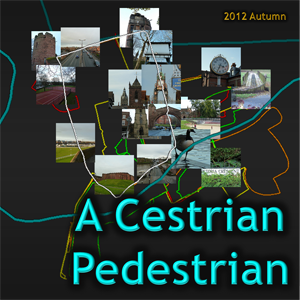 Article for 2012 Nov 17
Article for 2012 Nov 17
Part of the “A Cestrian Pedestrian” series.
2012
Appendix

For more information about Chester and its attractions, please consult ChesterWalls.info, VisitChester.com, EnglishHeritage.org.uk, and/or ChesterTourist.com. The first of these is particularly informative.
There is an appendix to this appendix, a table of photographs relating to the eight city gates.
The photos used to illustrate these articles may not have been taken on each day. Clicking on each image should display the Flickr page, on which is the actual date taken.
Nov 17 Sat
 I went on another walk around Chester today. It was nice. Especially as I finally found the Blue Bell Restaurant, the (sadly now closed for business) setting of the second of the stories to be told at that drama-group I’ve been assisting with. Turns out it’s just beyond the cathedral, on Northgate Street. I thump my forehead in self-disgust. Of course a restaurant named after bells is near the most major bell-tower/church in Chester!
I went on another walk around Chester today. It was nice. Especially as I finally found the Blue Bell Restaurant, the (sadly now closed for business) setting of the second of the stories to be told at that drama-group I’ve been assisting with. Turns out it’s just beyond the cathedral, on Northgate Street. I thump my forehead in self-disgust. Of course a restaurant named after bells is near the most major bell-tower/church in Chester!
This restaurant features the window of the widow-in-the-window story. During the seventeenth century, Chester was the last city to fall to the Parliamentarians in the Civil War. A short walk from from the Northgate is the Phoenix Tower, at the northeast corner of the citywalls; the tower was unknown to me until I walked that section of the walls. But the tower wasn’t unknown to King Charles and his army: according to the inscription on the tower’s side, “King Charles stood on this tower Sept 24 1645, and saw his army defeated on Rowton Moor”.
 ChesterTourist.com denies that inscription its veracity, on the grounds that Rowton Moor is several miles south-east of Chester, so the battle could not have been visible from the Phoenix Tower. But I’m more punctilious. The statement does not say King Charles saw the defeat of his army on Rowton Moor; it states King Charles saw his army [having been] defeated on Rowton Moor. It is entirely possible that the Royalists fled back to Chester after the battle, and then they were seen by the monarch, as indeed is suggested on that webpage.
ChesterTourist.com denies that inscription its veracity, on the grounds that Rowton Moor is several miles south-east of Chester, so the battle could not have been visible from the Phoenix Tower. But I’m more punctilious. The statement does not say King Charles saw the defeat of his army on Rowton Moor; it states King Charles saw his army [having been] defeated on Rowton Moor. It is entirely possible that the Royalists fled back to Chester after the battle, and then they were seen by the monarch, as indeed is suggested on that webpage.
 Like the Phoenix Tower, I hadn’t known about Rowton Moor before the drama-group introduced me to it. Like the Phoenix Tower, I’ve included the Moor on the poster advertisement I did for the play. Unlike the Phoenix Tower, where I’ve represented the Tower with a photo of it, I’ve represented the Moor with a photo of a somewhat related being, a moorhen. Gotta have a moorhen. So well adapted to water!
Like the Phoenix Tower, I hadn’t known about Rowton Moor before the drama-group introduced me to it. Like the Phoenix Tower, I’ve included the Moor on the poster advertisement I did for the play. Unlike the Phoenix Tower, where I’ve represented the Tower with a photo of it, I’ve represented the Moor with a photo of a somewhat related being, a moorhen. Gotta have a moorhen. So well adapted to water!
Rowton Moor is named as such because it’s the moor beside the village of Rowton.
(No moorhens, except potentially on the canal that runs past both Rowton and the Phoenix Tower.)
 The Phoenix Tower is named as such after the badge of the Painter’s Guild, one of the two companies (the other being the Barbers and Candle-makers) to co-habit the tower from 1613 onwards (hence the embossed date in the photo, though the stone itself wasn’t carved and inserted until the tower’s restoration in 1658, after the ravages of the Civil War / Siege of Chester in 1645).
The Phoenix Tower is named as such after the badge of the Painter’s Guild, one of the two companies (the other being the Barbers and Candle-makers) to co-habit the tower from 1613 onwards (hence the embossed date in the photo, though the stone itself wasn’t carved and inserted until the tower’s restoration in 1658, after the ravages of the Civil War / Siege of Chester in 1645).
I imagine the Phoenix Tower rising above the musket-fire that set the city aflame in ’45, like the bird that shares the name the tower bears...
Nowadays the city is not aflame, but awash, flooded with traffic and thoroughfares...
 But I had to go. After reaching the Eastgate, I inexplicably went Eastgate St / Bridge St / Pepper St / Lower St. John St / Eastgate St, thus visiting the Eastgate Clock for what was the third time today. I must have been caught in a whirlpool or something.
But I had to go. After reaching the Eastgate, I inexplicably went Eastgate St / Bridge St / Pepper St / Lower St. John St / Eastgate St, thus visiting the Eastgate Clock for what was the third time today. I must have been caught in a whirlpool or something.
Then I wandered off in search of the Watergate (the gate on the western walls), by going down Watergate St.
It sounds rational, looking for the Watergate on Watergate St. Indeed, Watergate St passes through the Watergate, like a little stream passing under a bridge. Unfortunately Watergate St is cut across by the heavily motorised St. Martin’s Way (part of the A5268, a name that more accurately describes St. Martin’s Way’s heartless ways).
 Upon arrival on the eastern bank of this Amazon river of a road, I turned a right angle to the left, scurried down the A5268 until I got to the Grosvenor Roundabout, where I forded the current (traffic lights are useful for this). I was on the western pavement of Grosvernor Road, which isn’t part of the A5268, though Grosvenor Street is, as is the rest of the Inner Ring Road.
Upon arrival on the eastern bank of this Amazon river of a road, I turned a right angle to the left, scurried down the A5268 until I got to the Grosvenor Roundabout, where I forded the current (traffic lights are useful for this). I was on the western pavement of Grosvernor Road, which isn’t part of the A5268, though Grosvenor Street is, as is the rest of the Inner Ring Road.
Over Grosvenor Bridge I walked, as home is in the suburbs beyond. But I noticed a narrow, unlit stepcase down the side of the road, and I was curious. The woods I found myself in were not the woods of the Grosvenor Estate (that’s on the other side of Overleigh Roundabout), through which I often walk to school. These woods were groundlevel, with the embankment the road’s upon rising up on the eastern flank like a protective frontier. I felt sheltered there, and wonder and admiration at this beautiful, sacred even island in the waters of the roadridden world of Chester.
 Unlike in the woods of Grosvenor, I saw no ghosts here.
Unlike in the woods of Grosvenor, I saw no ghosts here.
Yet my camera did: look at the photo. Breathtaking.
But I had to go. Mum would be missing me. No doubt she’d ask me where I’d been, and as I’d replied on Sep 22 with “Everywhere”, and as I’d gone today anywhere I hadn’t gone in September, today I’d reply “Nowhere”. Which reminds me. A footpath goes under the Grosvenor Bridge from these woods, past a house called Nowhere. Local legend links this cottage to a less local (and more legendary) pop group called the Beatles, for whose song “Nowhere Man” was the inspiration from this habitation’s appellation.
Unlike the eponymous Nowhere Man, I think I have a point of view; I know where I’m going to. That place being, I hope, home.
